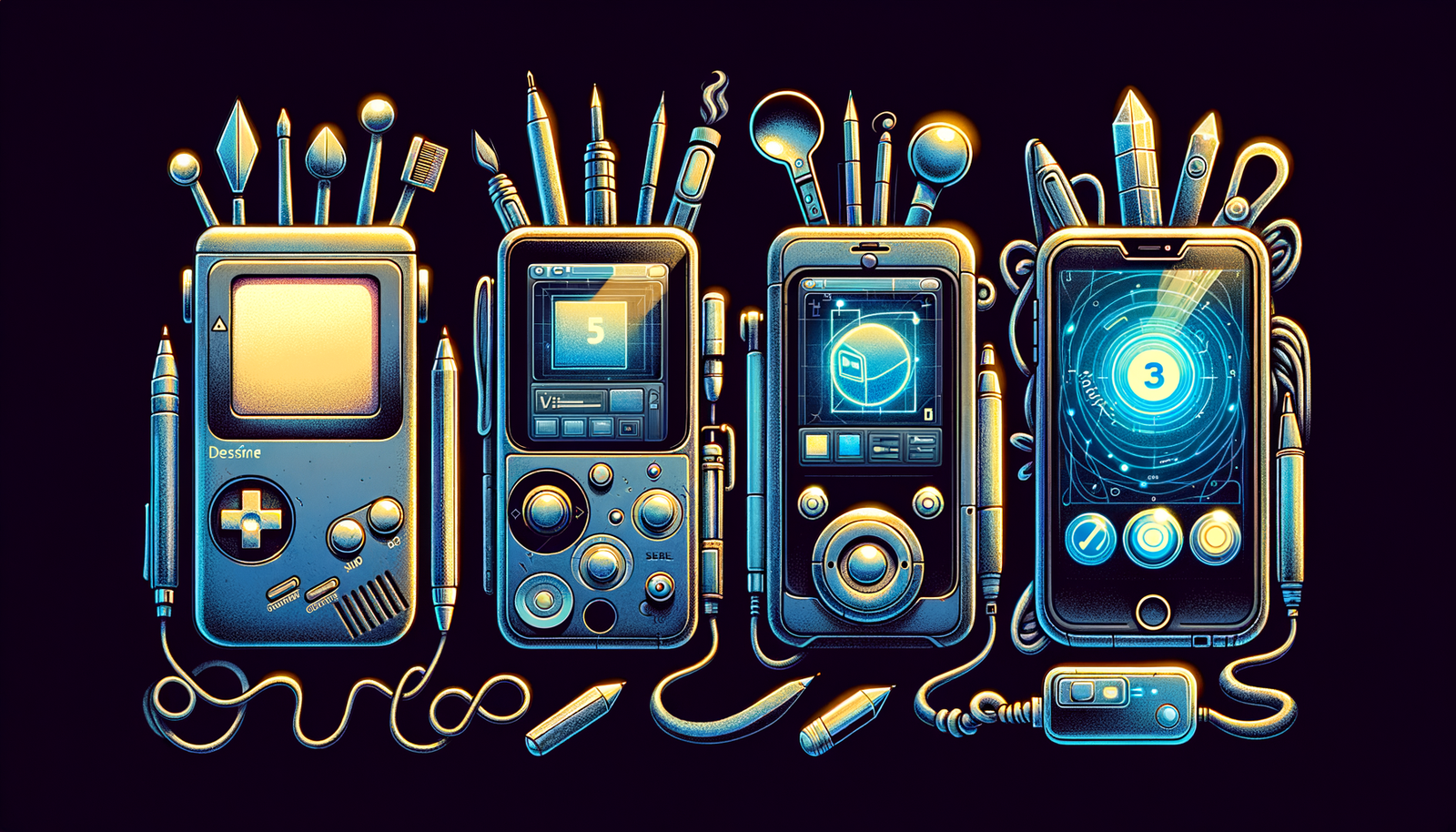Your Cart is Empty
Customer Testimonials
-
"Great customer service. The folks at Novedge were super helpful in navigating a somewhat complicated order including software upgrades and serial numbers in various stages of inactivity. They were friendly and helpful throughout the process.."
Ruben Ruckmark
"Quick & very helpful. We have been using Novedge for years and are very happy with their quick service when we need to make a purchase and excellent support resolving any issues."
Will Woodson
"Scott is the best. He reminds me about subscriptions dates, guides me in the correct direction for updates. He always responds promptly to me. He is literally the reason I continue to work with Novedge and will do so in the future."
Edward Mchugh
"Calvin Lok is “the man”. After my purchase of Sketchup 2021, he called me and provided step-by-step instructions to ease me through difficulties I was having with the setup of my new software."
Mike Borzage
Design Software History: The Evolution of Mobile Design Apps: Transforming Creativity On-the-Go
October 26, 2024 6 min read


Introduction
The transition from traditional design software to mobile applications represents a significant evolution in the design industry's landscape. For decades, designers relied heavily on powerful desktop computers equipped with specialized software to bring their creative visions to life. These setups, while robust, often tethered designers to specific locations and limited their flexibility. With the advent of mobile technology, however, there has been a profound shift toward mobile versatility in contemporary design practices. This shift acknowledges the modern designer's need to access tools and collaborate with others anytime and anywhere, breaking free from the constraints of traditional workspaces.
Several technological advancements facilitated this shift, most notably the development of sophisticated mobile operating systems and hardware. The emergence of smartphones and tablets equipped with high-resolution touchscreens, multi-core processors, and advanced graphics capabilities provided a new platform for design software. Innovations such as cloud computing and high-speed mobile internet access further enabled designers to store, access, and share large design files on the go. Collectively, these advancements have redefined the possibilities within the design industry, paving the way for mobile applications to become integral tools in a designer's arsenal.
The Genesis of Mobile Design Apps
In the early stages of mobile technology, devices were primarily designed for communication, basic internet browsing, and simple applications. The limitations in processing power, memory, and screen size made them ill-suited for handling complex design tasks. Early mobile operating systems lacked the support for graphics-intensive applications, and input methods were limited to basic touch controls without the precision needed for detailed design work. Consequently, designers remained reliant on desktop software, and the idea of creating professional designs on a mobile device seemed distant.
Key milestones in mobile computing began to change this landscape. The introduction of Apple's iPad in 2010 marked a significant turning point. With its larger screen, improved touch capabilities, and enhanced performance, the iPad offered a new medium for digital creativity. Developers started to see the potential for more sophisticated applications. The development of mobile operating systems like iOS and Android provided robust platforms that supported advanced functionalities. These operating systems evolved to include APIs and frameworks that developers could utilize to create more powerful and feature-rich applications.
Initial design applications began to emerge, capitalizing on these technological improvements. Apps like Paper by FiftyThree offered intuitive sketching interfaces that leveraged the touch capabilities of tablets. Adobe Ideas (later evolved into Adobe Illustrator Draw) allowed vector-based drawing on mobile devices, bringing professional-grade tools to the mobile platform. These early applications, while not as comprehensive as their desktop counterparts, demonstrated the potential for mobile devices to support serious design work. They laid the groundwork for the subsequent development of more advanced mobile design tools.
Evolution and Key Technologies
The evolution of mobile design applications has been propelled by several key technologies that enhanced their functionality and usability. One of the most significant advancements is the adoption of touchscreen interfaces and gesture-based controls. These interfaces allow designers to interact directly with their work through natural gestures, such as pinching to zoom or swiping to navigate, creating a more intuitive and immersive experience. The precision of touch inputs has been further enhanced with the introduction of stylus devices like the Apple Pencil and the Samsung S Pen, which offer pressure sensitivity and fine-point accuracy akin to traditional drawing instruments.
Another critical technology is cloud integration. By enabling file access and collaboration across devices, cloud services have transformed the way designers work. Designers can save their projects to cloud platforms and access them from any device, ensuring that the most up-to-date version of a design is always at hand. This capability is essential for collaborative projects where team members may be working from different locations. It allows for real-time updates and feedback, significantly improving productivity and coordination.
- Seamless synchronization across devices eliminates the need for manual file transfers.
- Real-time collaboration features enable multiple users to work on the same project simultaneously.
- Automatic backups safeguard against data loss by storing versions in the cloud.
The development of powerful graphic design engines on mobile platforms has also played a crucial role. Technologies like Metal for iOS and Vulkan for Android provide low-level access to the GPU, allowing applications to render complex graphics efficiently. This capability has enabled mobile apps to support advanced features such as 3D modeling, high-resolution image processing, and sophisticated visual effects. Combined with increasingly powerful mobile hardware, these technologies have significantly reduced the performance gap between mobile devices and traditional desktops.
Notable companies and applications have been instrumental in shaping the mobile design app landscape. Key players include:
- Adobe's Creative Cloud mobile applications: By adapting their flagship software for mobile, Adobe brought professional-grade tools like Photoshop and Illustrator to handheld devices.
- Procreate: An illustration app for iPad that offers a comprehensive suite of tools for artists, leveraging the iPad's capabilities to deliver a desktop-like experience.
- Affinity Designer: A vector graphics editor that provides full-fledged design capabilities on mobile devices, mirroring its desktop counterpart.
- Figma: While primarily browser-based, Figma's mobile app facilitates collaborative design work, emphasizing real-time interaction and cross-platform compatibility.
- Canva: A user-friendly design platform that expanded to mobile, allowing users to create designs for social media, presentations, and more with ease.
The Current Landscape of Mobile Design Apps
Today, mobile design applications have matured to the point where they offer a robust set of features that rival traditional desktop software. Applications like Affinity Designer and Procreate provide professional-grade tools that cater to both casual users and design professionals. These apps are optimized for touch input and often take advantage of the unique capabilities of mobile devices, such as accelerometers and high-resolution touchscreens, to enhance the user experience.
When comparing features between desktop and mobile versions, it's clear that the gap has significantly narrowed. Mobile apps now support:
- Advanced layer management and blending modes, essential for complex compositions.
- High-resolution canvas sizes suitable for print and detailed digital work.
- Extensive brush libraries and customization options for personalized toolsets.
- Vector and raster editing capabilities, allowing for a versatile workflow.
The user base for mobile design applications has expanded dramatically. Professionals appreciate the convenience of being able to work on projects while traveling or away from their primary workstations. The ability to quickly sketch ideas, make edits, or even present designs to clients directly from a tablet or smartphone enhances productivity and responsiveness. Usability insights indicate that while desktop applications remain vital for certain tasks, mobile apps offer a complementary tool that integrates seamlessly into the modern designer's workflow.
In remote work environments, mobile design apps have become indispensable. The global shift toward remote work has highlighted the importance of tools that support global collaboration. Mobile apps enable designers to participate in projects, provide input, and stay connected with their teams regardless of their physical location. The integration of communication tools within design apps further streamlines the collaborative process, allowing for instant feedback and real-time problem-solving.
Conclusion
The transformative impact of mobile design applications on the design industry is profound. They have democratized access to powerful design tools, allowing a broader range of individuals to engage in creative work without the need for expensive hardware or being confined to a specific location. The ability to integrate mobile apps into existing workflows has enhanced flexibility and responsiveness, essential qualities in today's fast-paced environment.
Looking toward the future, several trends are poised to shape the next generation of mobile design software. The integration of artificial intelligence (AI) stands to revolutionize design processes by automating routine tasks, providing intelligent suggestions, and enabling more personalized user experiences. AI-powered features could assist with layout optimization, color palette generation, and even content creation, augmenting the designer's capabilities.
Augmented reality (AR) is another area with significant potential. By overlaying digital information onto the physical world, AR can provide new ways for designers to visualize and interact with their work. This technology could enable on-site design adjustments, real-time environmental visualization, and more immersive presentations to clients. As AR hardware and software become more accessible, their integration into mobile design apps is a natural progression.
Ultimately, the enduring importance of adaptability in design processes cannot be overstated. As new technologies emerge, designers must be willing to embrace change and leverage new tools to stay competitive. The shift to mobile design apps exemplifies this adaptability, highlighting the industry's capacity for innovation and growth. By remaining open to new possibilities, designers can continue to push the boundaries of creativity and efficiency, shaping the future of the industry.
Also in Design News

Revit Tip: Drive QA and Clarity with Revit Schedule Graphics and Conditional Formatting
January 05, 2026 2 min read
Read MoreSubscribe
Sign up to get the latest on sales, new releases and more …




